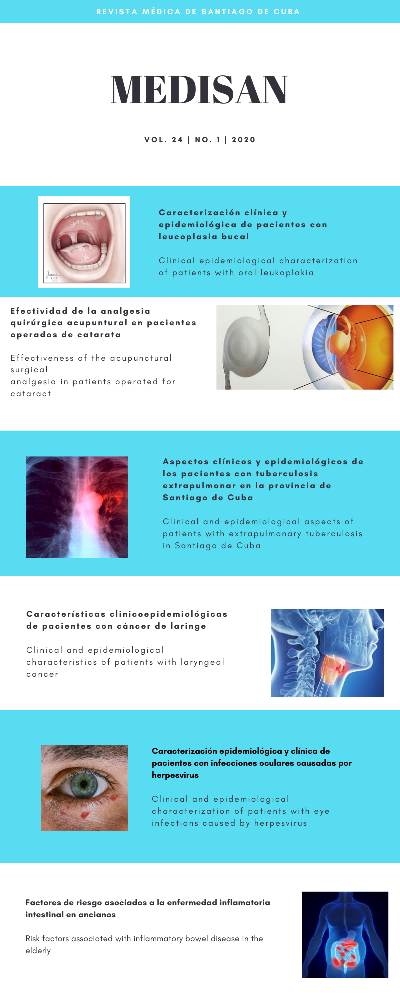Impact of sociocultural factors in the reproductive health of women in Guayaquil University
Keywords:
féminas, factores socioculturales, salud sexual, salud reproductiva, planificación familiar.Abstract
Introduction: The sexual and reproductive health is important for the general well-being of women and decisions making on the family planning; however, there are sociocultural factors that condition unfavorably the abovementioned aspects.
Objective: To determine the sociocultural factors that conditioned unfavorably the reproductive health of students atGuayaquilUniversity.
Methods: A descriptive and observational investigation of 120 students was carried out, they attended the gynecoobstetrics service ofGuayaquil University,Ecuador, during 2019.
Results: The interviewed aged 18 and 29 (82.0 %); 55 % didn't receive or ignored the existence of sexual orientation services that were offered to the adolescents of this university. Also, 60.0 % of women stopped going to health centers to get ready on topics of sexual and reproductive health and they abandoned the protection when having sexual relationships due to lack of economic means.
Conclusions: The sociocultural factors influenced significantly in the access to the services of sexual and reproductive health that were offered to the adolescents in the university with emphasis in the absence of economic means.Downloads
References
2. González Galbán H, Vega Briones G. Problemáticas del comportamiento sexual y reproductivo de las jóvenes inmigrantes de Baja California. Frontera norte. 2013 [citado 18/ 01/19]; 25 (50): 131-54. Disponible en: http://www.scielo.org.mx/pdf/fn/v25n50/v25n50a6.pdf
3. Ordoñez Bacter A, Suárez F. Exploración sobre los conocimientos del ácido fólico y sus beneficios en la salud reproductiva en una población universitaria colombiana. Rev Colomb Obstet Ginecol. 2006; 57 (4): 271-8.
4. Saeteros Hernández RC, Díaz Bernal Z, Sanabria Ramos G, Pérez Piñero J. Representaciones socioculturales sobre el ideal de la salud sexual y reproductiva en estudiantes universitarios ecuatorianos. Rev Cubana Salud Pública. 2015 [citado 23/01/2019]; 41 (3): 459-75. Disponible en: http://scielo.sld.cu/scielo.php?script=sci_arttext&pid=S0864-34662015000300006&lng=es
5. Ecuador. Ministerio de Salud Pública. Plan Nacional de Salud Sexual y Salud Reproductiva 2017-2021. Ecuador: Viceministerio de Gobernanza de la Salud Pública; 2017 [citado 19/03/2019]. Disponible en: https://ecuador.unfpa.org/sites/default/files/pub-pdf/PLAN%20NACIONAL%20DE%20SS%20Y%20SR%202017-2021.pdf
6. Consejo Nacional de Población. Situación de la salud sexual y reproductiva. México: Consejo Nacional de Población; 2016 [citado 19/03/2019]. Disponible en: https://www.gob.mx/cms/uploads/attachment/file/237216/Cuadernillo_SSR_RM.pdf
7. González Moreno JM. Los derechos sexuales y reproductivos como categoría jurídico internacional revisable. Rev. derecho público. 2017 [citado21/03/2019]; (38): 1-29. Disponible en: https://dialnet.unirioja.es/descarga/articulo/6331698.pdf
8. Secretaría de Salud. Planificación familiar y anticoncepción 2013-2018. Programa Sectorial de Salud. México: Secretaría de Salud; 2018[citado 20/01/2019]. Disponible en: http://cnegsr.salud.gob.mx/contenidos/descargas/PlanFam/PlanificacionFamiliaryAnticoncepcion.pdf
9. Organización Mundial de la Salud. Planificación familiar. Suiza: OMS; 2018 [citado 18/01/2020]. Disponible en: https://www.who.int/es/news-room/fact-sheets/detail/family-planning-contraception
10. Instituto Nacional de Estadística e Informática. Planificación Familiar. 2018 [citado 21/03/2019]. Disponible en: https://www.inei.gob.pe/media/MenuRecursivo/publicaciones_digitales/Est/Lib1656/pdf/cap004.pdf
11. IPPF. Salud y derechos sexuales y reproductivos: la clave para alcanzar la igualdad de género y el empoderamiento de las mujeres. London: Federación Internacional de Planificación Familiar; 2015 [citado 05/04/2019]. Disponible en: https://www.ippf.org/sites/default/files/ippf_2020_gender_2015_spa_web.pdf
12. Cleland J, Shah IH, Benova L. Una mirada fresca al nivel de necesidad insatisfecha de planificación familiar en el periodo posparto, sus causas e implicaciones programáticas. International perspectives on sexual and reproductive Health. 2015 [citado 18/01/2019]: 165-62. Disponible en: https://www.guttmacher.org/es/journals/ipsrh/2015/09/una-mirada-fresca-al-nivel-de-necesidad-insatisfecha-de-planificacion
13. Villacres Guamba LV. La asesoría de planificación familiar como factor de adherencia a métodos anticonceptivos entre mujeres adolescentes y adultas que acuden a consulta externa en el Centro de Salud Archidona (Napo -Tena) en el periodo de mayo a junio del 2016 [Tesis]. Quito: Universidad Central de Ecuador; 2016 [citado 28/03/2019]. p. 21-9. Disponible en: http://www.dspace.uce.edu.ec/bitstream/25000/11764/1/T-UCE-0006-010-2016.pdf
14. Gayet CI, Juárez F. Estimación de las necesidades no satisfechas de métodos anticonceptivos en México a través de la ENADID 2014. Realidad, Datos y Espacio. Revista Internacional de Estadística y Geografía. 2018 [citado2019 abril 5]; 9 (2): 54-65. Disponible en: https://www.gob.mx/cms/uploads/attachment/file/237216/Cuadernillo_SSR_ RM.pdf
15. Organización de las Naciones Unidas. Objetivo 3: Garantizar una vida sana y promover el bienestar para todos en todas las edades. 2017 [citado 28/03/2019]. Disponible en: http://www.un.org/sustainabledevelopment/es/health/
16. Organización Panamericana de la Salud. Estado actual de la salud de los adolescentes y jóvenes en la región de las Américas. 2018 [citado 28/03/2019]. Disponible en: https://www.paho.org/informe-salud-adolescente-2018/part-two-the-current-status-of-the-health-of-adolescents-and-youth-in-the-americas.html
17. Organización Mundial de la Salud. Infecciones de transmisión sexual. 2019 [citado 05/04/2019]. Disponible en: https://www.who.int/es/news-room/fact-sheets/detail/sexually-transmitted-infections-(stis)
Published
How to Cite
Issue
Section
License
All the articles can be downloaded or read for free. The journal does not charge any amount of money to the authors for the reception, edition or the publication of the articles, making the whole process completely free. Medisan has no embargo period and it is published under the license of Creative Commons, International Non Commercial Recognition 4.0, which authorizes the copy, reproduction and the total or partial distribution of the articles in any format or platform, with the conditions of citing the source of information and not to be used for profitable purposes.





